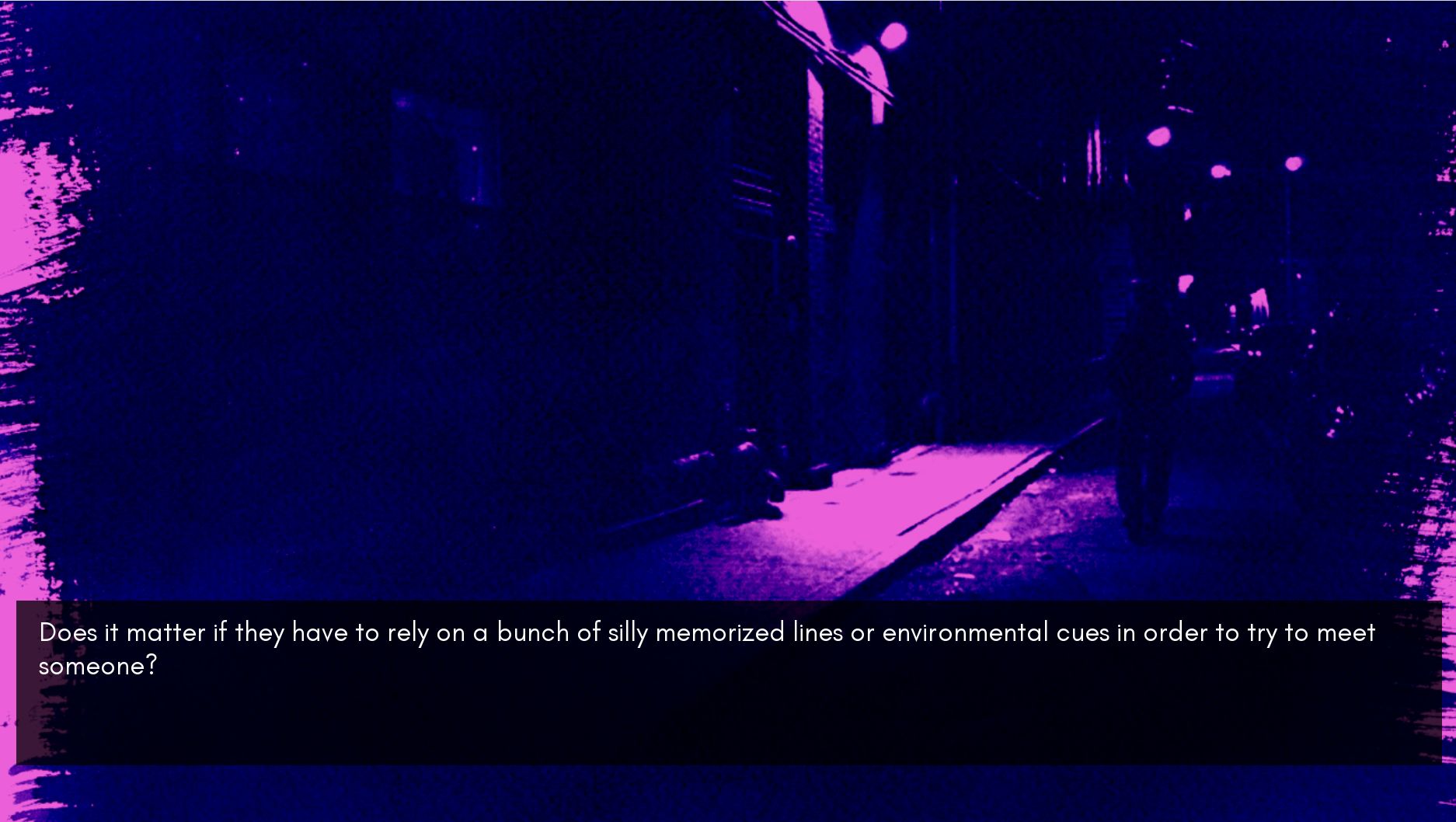This interview is part of a series of interviews with artists who have a significant body of work that makes use of or responds to network culture and digital technologies.
Celine Katzman: I admire the diligent patience you demonstrate in the face of misogyny, which was especially obvious to me in your interview with the notorious writer and manosphere figurehead Roosh V for your project BANGED. Is there an interaction in your research or practice that stands out to you as the most frustrating? Were you able to keep your cool?
Angela Washko: In the interview portion of my project BANGED, it was important to me to me that I show the manosphere (an anti-feminist network of people, blogs, books etc. mobilized around the notion that men are more oppressed than women) that their ideas about what or who a feminist is are incredibly limited. I wanted to disprove much of their community’s commonly held belief that feminists are not interested in hearing about the struggles of people who aren’t like them. So I decided to try my best to make myself an example of someone who is willing to listen to the views of someone who is just about the most opposite to them as possible. I was also becoming frustrated with the lack of significant research happening around the manosphere. It is not given the critical analysis I thought (and still think) it should be given, considering its growing numbers as more and more women have accumulated the language, the platforms, and the communal consciousness to demand their liberation. Although there was certainly no shortage of writing about Roosh V and the manosphere, it was largely relegated to shock media—this “look how ridiculous these guys are, my liberal friends!” sort of news media. I sought out to understand more deeply the motivation of the men who had opted to position themselves in contrast to progressive movements to empower women as a way of strategizing a resistance to them.
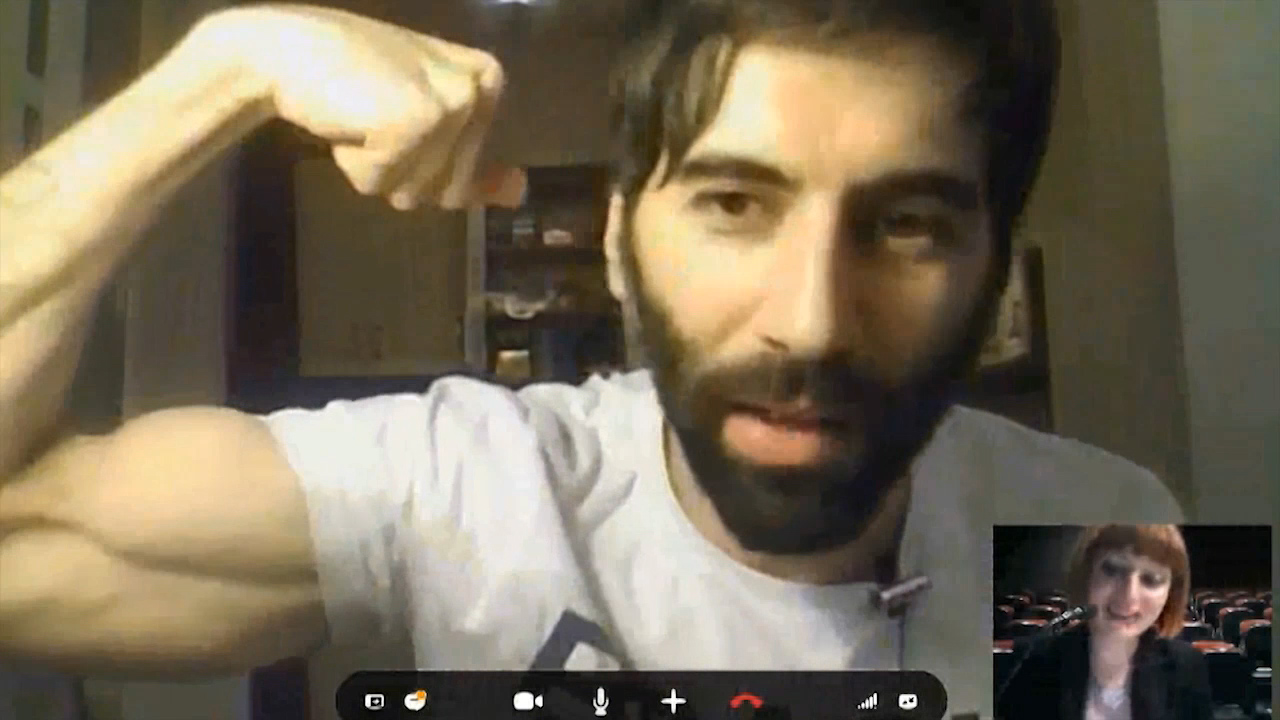 BANGED: An Interview with Roosh V, Angela Washko, performance for video, 2015 (still)
BANGED: An Interview with Roosh V, Angela Washko, performance for video, 2015 (still)
This was during a time during which I was invested in having a practice that existed outside of traditional art spaces, as I had found success operating as The Council on Gender Sensitivity and Behavioral Awareness in World of Warcraft for four years—a project through which I had been facilitating discussions with the playerbase about the exclusion (or frankly, discrimination) of players on the basis of race, gender, and sexuality. As a performer who had seen real impact on the space in World of Warcraft as a result of my actions as The Council… I naively applied some of the same logic and strategies to this project without realizing the primary difference in my position in these two spaces. In WoW I was recognizable as a long term, high level member of the community with high level gear only obtained through years of commitment to the game—clearly a participant and not an outsider. In Roosh V’s manosphere, I was an enemy, a symbol of everything wrong in today’s world to them—someone who operates against their values and someone who regardless of attempts to be civil in an interview and even at times acting with something that did feel like empathy. There was no way this project would have ended smoothly for me. So I went into the project recognizing that entering a space that I didn’t belong would have consequences, but nothing would have prepared me for the extent of those consequences (beyond my treatment in the interview itself—facing over a year of sustained harassment from his extended community). I don’t know that I would call this exchange frustrating—I think I am more frustrated by larger online platforms that allow white supremacist, highly patriarchal and abusive communities to exist and thrive...as well as the news sites that benefit from clickbait articles about them that don’t go into any depth about their emergence/impact/etc.
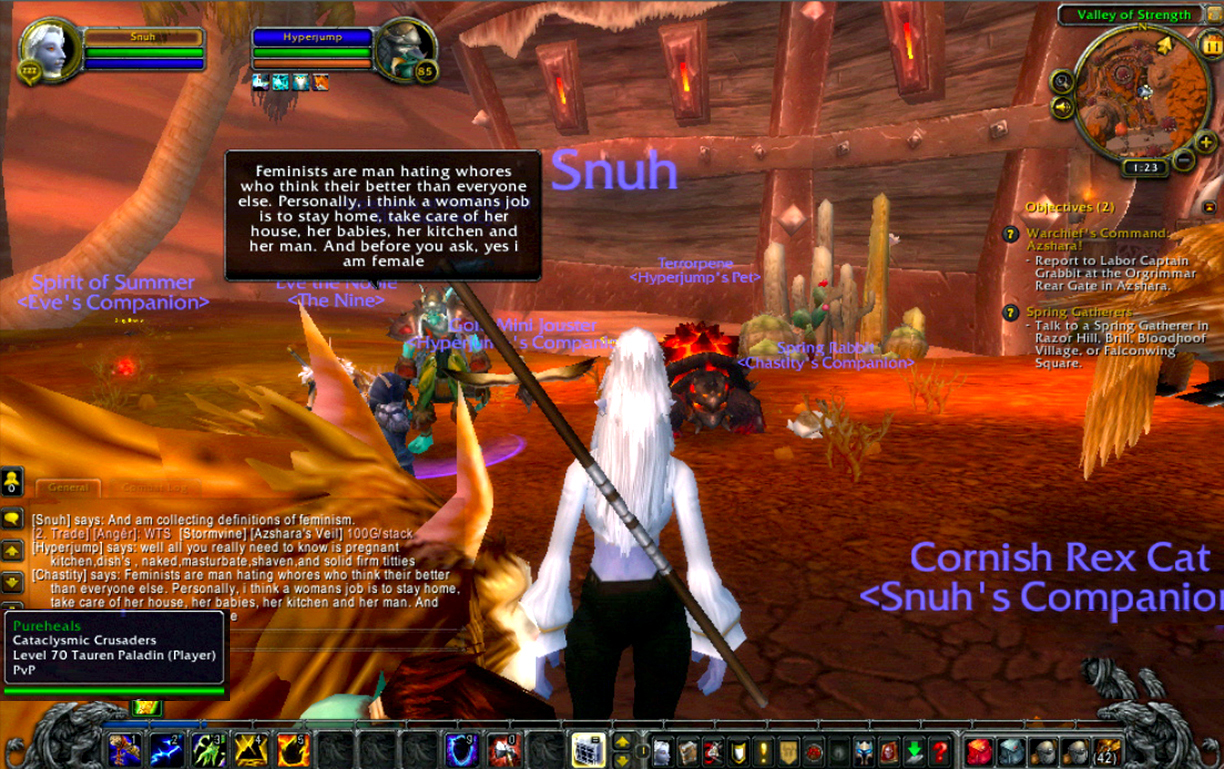 Chastity (From The Council on Gender Sensitivity and Behavioral Awareness in World of Warcraft), performance for video, 2012 (still)
Chastity (From The Council on Gender Sensitivity and Behavioral Awareness in World of Warcraft), performance for video, 2012 (still)
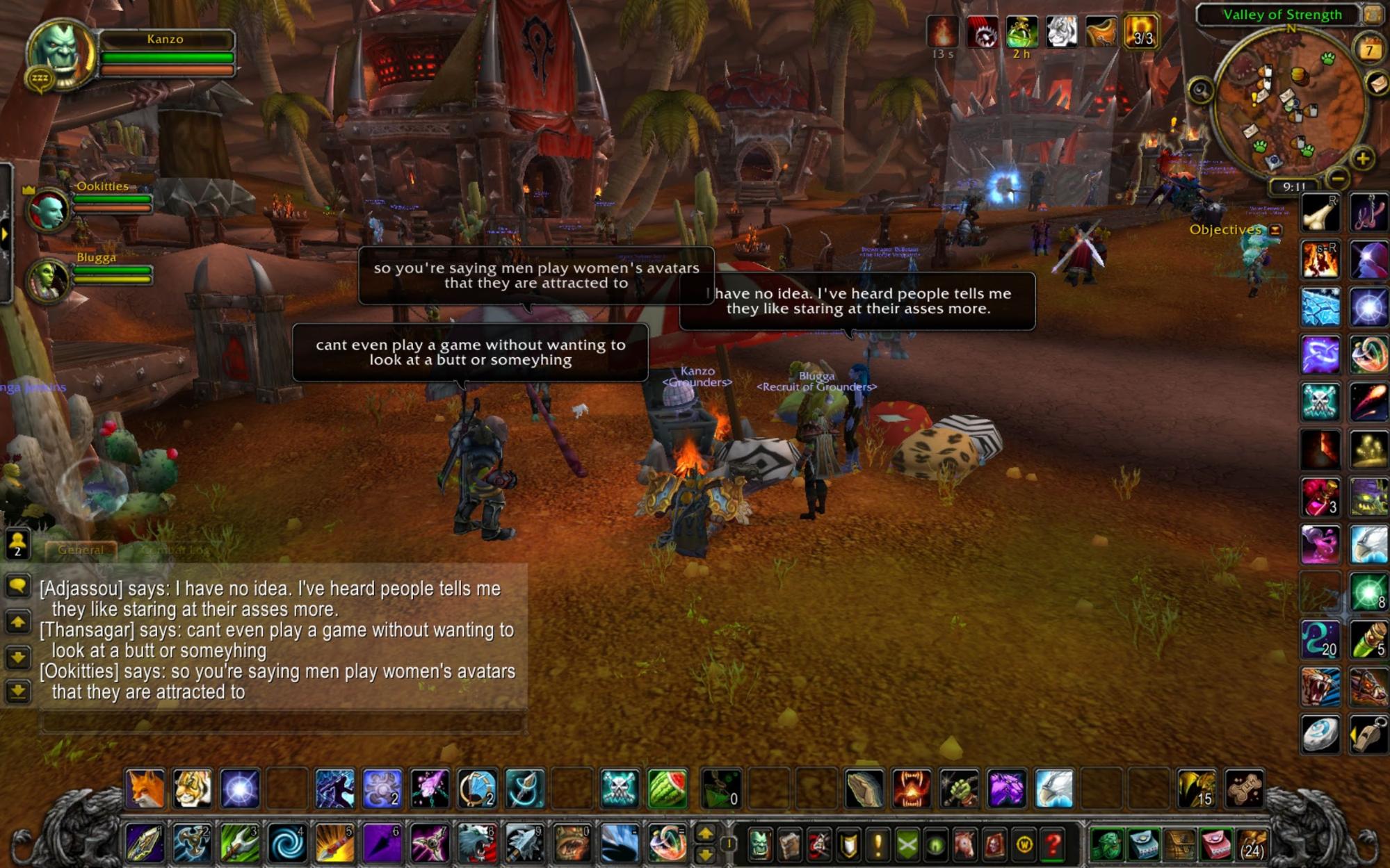 We Actually Met in World of Warcraft (From The Council on Gender Sensitivity and Behavioral Awareness in World of Warcraft), performance for video, 2015 (still)
We Actually Met in World of Warcraft (From The Council on Gender Sensitivity and Behavioral Awareness in World of Warcraft), performance for video, 2015 (still)
CK: Did you find a particular demographic of players more receptive to The Council on Gender Sensitivity and Behavioral Awareness in WoW than others? How have the responses to the project from the in-game community progressed over the years?
AW: I operated The Council on Gender Sensitivity and Behavioral Awareness in World of Warcraft from 2012 to 2016. The responses to the project really shifted along with the intentions that I had with it. In the beginning I went into the project asking players to discuss the treatment of women in the game because I had experienced sexual harassment, incredible condescension, a very commonly held belief that being “worse” in the game was biologically linked to being a woman, general dismissal (“get back in the kitchen and make me a sandwich” was an incredibly popular phrase for example), and blatant favoritism (including gifts of gold, equipment, etc) just for being a woman. When I started playing the game in 2006, this was just accepted (even by me) as a natural part of the game culture. The way the social environment in WoW varies for women has been a huge factor for me quitting the game several times. In 2012 I decided that instead of ignoring it or abandoning the often rich and intimate social space because of it, that I would try a new approach—holding public discussions about these issues inside the game with the rest of the players on my server. In the beginning I had hoped that it might create a solidarity movement with other players who felt oppressed by some of the oppressive language and behaviors of the community and ultimately change the language on the servers I played on.
However as time went on, I started to feel that trying to change the space in my own image of what it should be like started to feel a bit colonial in its impulse—especially as I was presenting WoW in art contexts that are typically unfamiliar with the space. So my focus shifted away from changing the informal social culture of the space to creating safe public meeting spaces for discussions in order to create visibility and platforms for those who felt marginalized to be represented and to speak for themselves. This drastically improved the participation of the project as well. It became a lot less top-down and a lot more about the complexities of how the community’s exclusive language emerged, the complexities of being complicit with it in order to survive in the space (as women’s scarcity is also a benefit...the fewer women there are, the more valuable they are to the social culture of guilds at more competitive and more social levels), and the complexities of people feeling silenced in physical space and using this social game environment as a place to express suppressed political views and increasingly culturally unacceptable fantasies. The players most positively impacted by The Council were players who love the game and have developed ten year long relationships with other players who they regard as some of their closest companions...but have also had traumatic experiences inside the space and haven’t had a platform to talk through those issues because there is no mechanisms in place for doing so either at the formal reporting level (contacting the developer) or socially/informally in most communities inside WoW.
For example: in my video Safety (Sea Change): An Interview in World of Warcraft, two other members of The Council join me to interview a player who reached out to me over email to talk about how her experience working in domestic violence counseling paralleled experiences she’s had and witnessed in the game...as well as what her social communities in WoW have done to support her and others in harassment situations. The other players most positively impacted by The Council have been players who have never actually talked to a self-identified feminist in their lives and members of The Council get to provide them with their first experience—which starkly contrasts the images they’ve been fed by the niche media they consume.
 Survival Rates In Captivity (Free Will Mode #5), dual-channel video, 2016 (still)
Survival Rates In Captivity (Free Will Mode #5), dual-channel video, 2016 (still)
CK: Survival Rates In Captivity (Free Will Mode #5) and your work in The Council on Gender Sensitivity and Behavioral Awareness in World of Warcraft both highlight how real world cultural biases leak into virtual spaces both by way of their users’ behavior and the structure of the games themselves. Do you have any tips for architecting more utopian virtual game spaces?
AW: The Sims (the game that Free Will Mode was made with) is single player and World of Warcraft is massively multiplayer, so the scales of experience are very different. In general, single player role-playing game experiences are more linear and much more narrative focused than MMORPGs—which although they have narratives, are often much more socially oriented and much more open in terms of what you end up doing… So different spaces and formats warrant different approaches to design. World of Warcraft has an issue with losing diverse players. On any given server you won’t find many queer players, female players, or players of color. However a mechanically very similar MMORPG like Final Fantasy XIV with essentially the same interface and battle structure, has many intentionally inclusive Free Companies or guilds (including the FC/guild I’m a part called RainbowBrigade which has a greeting tag line of “Welcome to The Rainbow Chateau! All are welcome and accepted here!”). How does one game end up being a magnet for homophobia, racism, and misogyny (WoW)...and another fundamentally similar game becomes populated with a plethora of safe spaces for marginalized identities (FFXIV)? In my experience playing a broad array of multiplayer online games, there is a direct correlation between the competitive culture of game spaces and the community’s attitudes therein. Games that are more expert-driven with a focus on high level competitive play are frequently plagued by more aggressive and exclusive player bases. This is evident in lots of first person shooters. One will find hate speech immediately upon entering Counter-Strike (which has a highly competitive culture), but less so in Team Fortress 2 (which until very recently had barely any competitive culture). Final Fantasy XIV intelligently incorporated incentives to being kind to new players in their collaborative play structures. In World of Warcraft (at least during the active years of The Council), if you are a new player doing a dungeon for the first time with a bunch of expert players, it is likely that you will be harassed and discouraged for being unskilled (often accompanied by racial or gender oriented slurs and insults). In Final Fantasy XIV, players who complete a dungeon with new players are given bonus experience points and are encouraged to give “commendations” (an award metric for strong performances in collaborative battles) to build players’ confidence. It is amazing how much this seemingly simple structural inclusivity changes the culture of the latter MMORPG. I have never seen another player harassed (nor been harassed) in more than two years of playing FF XIV. There are also most definitely more women playing FFXIV than WoW. So my point is if you want to create a multi-user game environment that makes people with diverse identities feel safe and included, step one should be incentivizing collaboration and support for players regardless of ability over strict competition. This sounds familiar though, right? WoW is much more ruthlessly “meritocratic,” while FFXIV sounds socialist in comparison. ;)
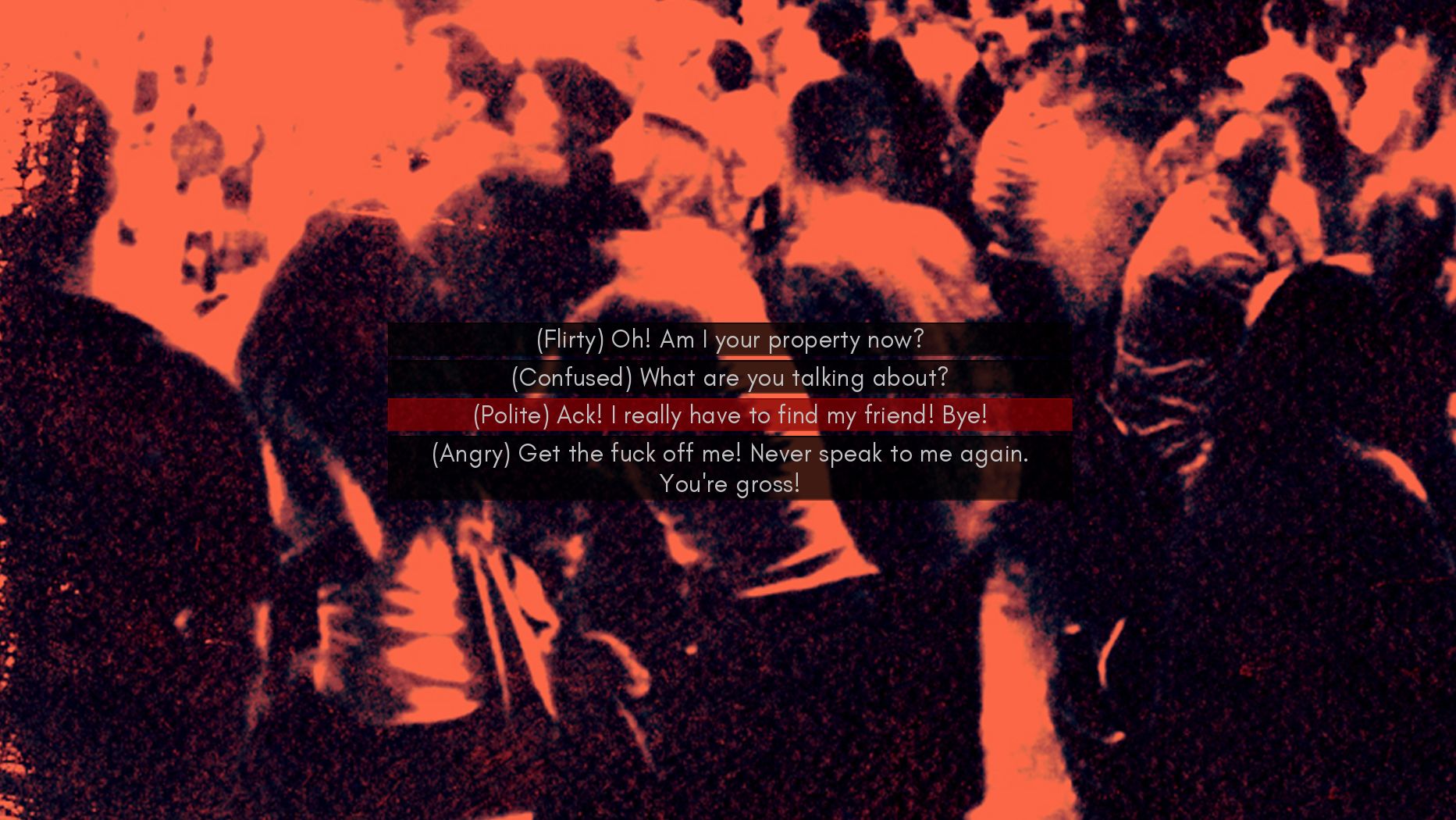 The Game: The Game, Ren’Py application, 2017 (still)
The Game: The Game, Ren’Py application, 2017 (still)
CK: Directly experiencing and responding to the manipulative dating strategies of RSD Julien and “Luke” while playing Chapters 1 and 2 of The Game: The Game was really illuminating with regards to recontextualizing past IRL interactions I’ve had with men. Since embarking on this project, have you been subject to similar IRL interactions as those depicted with “Luke” and Julien? How has your counter-strategy to dealing with practitioners of game evolved?
AW: The Game: The Game is a video game designed to give players the experience of interacting with a series of famous pick-up artists and seduction coaches whose dialogue and behaviors have been constructed using their own words and teachings from books and instructional videos. The impulse to make this game wouldn’t have existed if I hadn’t been plagued by these types of interactions when I was younger. I’ve always had the same strategy if I wasn’t interested in the person trying to interact with me at bars and clubs...my strategies are often one of the many options you have when you’re playing through The Game: The Game. My strategy usually started with being polite and stating that I was just trying to spend time with my friends...which if someone persisted transitioned into me ignoring the person...and if they still persisted transitioned into me politely but firmly asking them to leave. I think one of the challenges to suggesting counter-strategies for dealing with the way that some of the figures in the seduction community practice pick-up is that many of them specifically target women who are quite intoxicated. You can see it in their hidden camera in-field videos (at least for the PUAs who sell in-field videos along with their instructional materials). Very often their pick up is effective because they attempt to heighten the emotional responses of women who are visibly intoxicated and vulnerable. You can experience this in the way that all of the pick-up artists engage you in Chapter 1 & 2. Because I’m in my thirties now, I’m not necessarily the target that the two primary figures in these chapters are looking for. Not all PUAs focus on the 18-29 age range, but “Luke” certainly does. “Luke” and Julien are not interested in someone who is ambitious, independent, intelligent, or experienced. The crux of their game is seeking out women who are submissive, young, vulnerable, and inexperienced enough to find their approaches appealing. It’s really important to me that in The Game: The Game I don’t shame anyone who is interested in pursuing casual hook ups. It is completely possible for you to opt to go home with one of these figures in the game. However, the way that those exchanges play out is based on stories that the PUAs have told about their personal “conquests” and some of them are pretty unpleasant for the women involved. I’m not projecting what these conquests might be like, but rather using anecdotal stories that the PUAs tell to their own communities.
I guess in terms of counter-strategy, consciousness that there are patterns that one can look for when going out that you can ask yourself can go a long way. Here are some questions you can ask yourself if you find yourself trying to assess if you’re dealing with a PUA attepting to create a false sense of familiarity with you: How fast does he accelerate to touching you? Does he try to isolate you from your friends? Does he try to get you to leave the venue and go elsewhere? Does he consistently try to get you to do things you’re uncomfortable with and reframe them as an adventure? These are a few consistent strategies employed by the PUAs in Chapter 1 and 2.
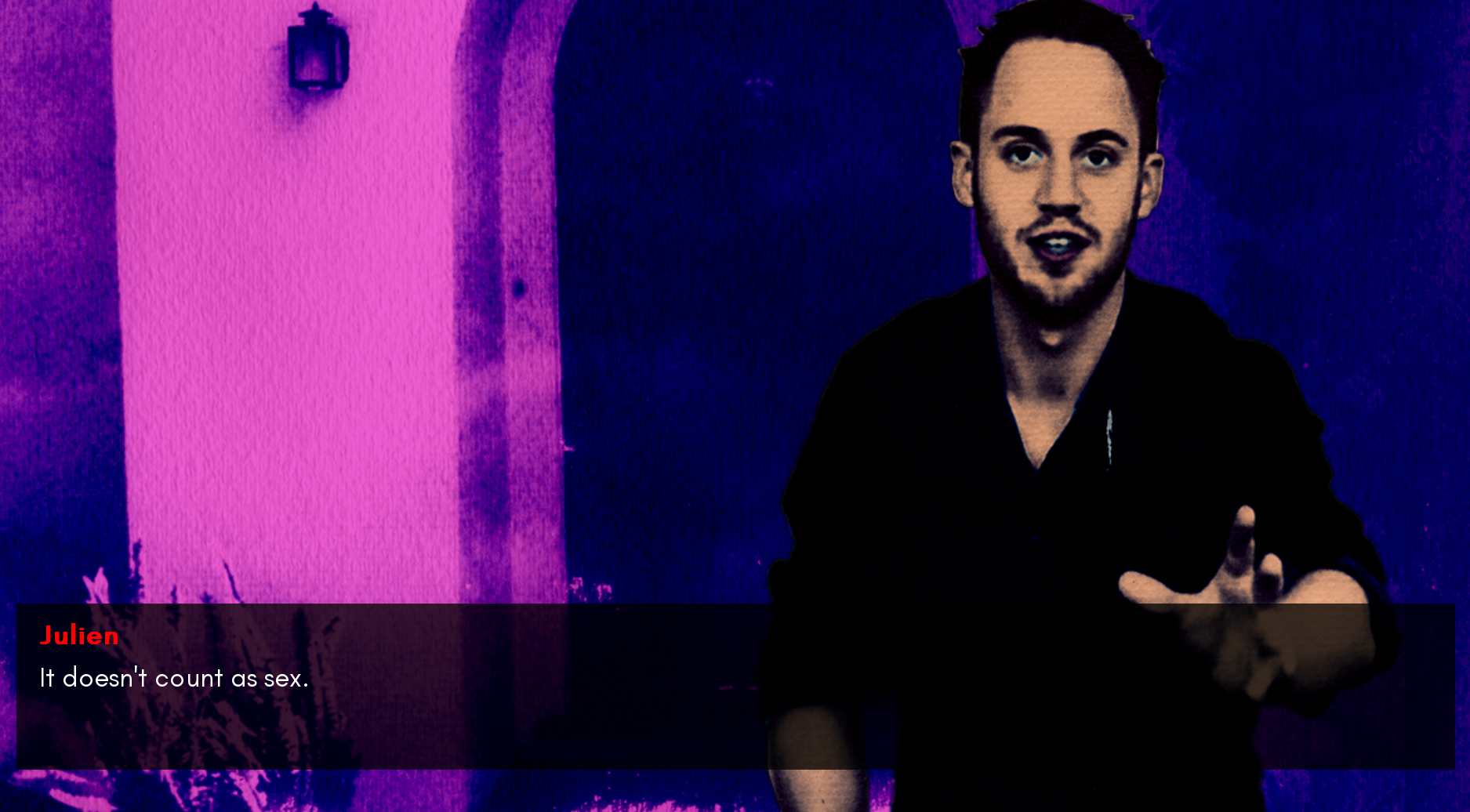
The Game: The Game, Ren’Py application, 2017 (still)
CK: I found your depiction of “Luke” and Julien very human, which is commendable given the obvious ideological differences that you have with them. In fact, there were moments in The Game: The Game where I felt pity and sympathy for practitioners of game. In 2014 Roosh came under fire for claiming teaching game would be a solution to tragedies like the Isla Vista mass murder in which the gunman cited involuntary celibacy as a motivation. I think treating the wellbeing of these men as a feminist issue is judicious, but how do you reconcile that with these specific incidents of mass harm of women? Is the desired end game here total empathy from both communities and if so, is there a way to to achieve that for us as women while practicing self-preservation?
AW: To me it is important that The Game: The Game reveals the complexity of this field while still being accessible and creating an embodied experience of it. There are so many figures in this field publishing books, crafting their own mythologies, cultivating their own followings...many of them running successful seduction coaching companies. It’s important to me that this field is given some serious study—it’s been easily dismissed as ridiculous for a long time. I wanted to create a way to experience the breadth of these types of practices and map out the differences and similarities in theory and tactical approach for people who are not familiar with these communities. I decided that the game format would allow me to have the PUAs speak for themselves using their own words from their books and instructional videos and create opportunities for players to experience their practices firsthand and respond as though this is happening to them in the most common place for pick-up art...a bar. This way the PUAs’ practices become less abstract and the comparisons of their behaviors/strategies can be made through the player’s embodied experience rather than a more diagrammatic approach or writing a book, which were other ways I considered mapping out this field.
I don’t want players to simply feel compassion or demonization for these figures or the field of pick-up art in general. To do so would fall into the dichotomous trap that I see nearly everyone covering this field in mainstream media falling into. The field is attractive to a lot of writers because it is easy to dismiss as horribly misogynistic toward women if you’re coming from a feminist perspective OR easy to glorify as supporting men by leveling the dating playing field for men who lack dating social skills if you’re coming from the manosphere perspective. I think it is totally possible to be empathetic toward men who find these teachings appealing and useful for building the confidence to approach and meet women...and still be critical of those pick-up artists who ultimately undermine, disregard, and fundamentally loathe the concept of consent. This is a larger threat to women’s autonomy in a time when there is a fundamental institutional fear in the U.S. of women truly being able to thrive and have consent over what happens to their own bodies every day. I want to leave players to wrestle with those gray-area complexities, because we aren’t given licence to accept how difficult these situations are today. I am tired of shitty, compromising, overly simplified A or B options. I hope that Xiu Xiu’s soundtrack to the game and the hand-made and digitally manipulated cyanotypes also help to amplify the stakes, risks, complexities, and uncertainties involved in being the target of this fraught terrain. I don’t believe in the whole empathy-games thing going on the VR industry, but I know that cis men who play the game have responded to it with a lot more shock than the femme-presenting people who have played it, because they haven’t had that embodied experience before. The femme-presenting people who play it already know the feeling all-too-well.
---
Header image: The Game: The Game, Ren’Py application, 2017 (still)
---
Age:
30
Location:
Pittsburgh, PA
How/when did you begin working creatively with technology?
Well I’ve been a gamer for as long as I can remember, but I was designing room descriptions in my Clantown in text-based mud game Medievia (late 90s / early 2000s)! I played a lot of video games but didn’t realize that my perspective on the sociocultural issues embedded in them might be worth investigating in an art context until I went to an artist residency and started re-playing the role playing games I grew up with, finding that the ideologies communicated had impacted my childhood understandings of gender and sexuality. I started creating video works that presented the ways that women were represented in the games I had played in a series called “Heroines with Baggage” (written about by Orit Gat on Rhizome here) in 2011. This project was the first time I started analyzing the content and byproducts of technology and presenting these findings as artworks. *Also because of some overlap in critique and intention—I want to mention that this project came before Anita Sarkeesian’s Tropes vs. Women in Video Games (an important pedagogical video series breaking down representation issues in video games—an undertaking which garnered Sarkeesian a great deal of harassment online).
Where did you go to school? What did you study?
My BFA is from Tyler School of Art (I studied painting and photography).
My MFA is from UC San Diego. (The program was generally visual art, but I was in the interdisciplinary computing in the arts focus.)
What do you do for a living or what occupations have you held previously?
I’m an Assistant Professor of Art at Carnegie Mellon University in Pittsburgh.
I’ve also taught at Bauhaus University and UC San Diego. Before that I was the studio manager for several other artists, a gallery associate at a number of art galleries in NYC, the residency coordinator at Flux Factory, a bartender, and an interior house-painter.
What does your desktop or workspace look like? (Pics or screenshots please!)
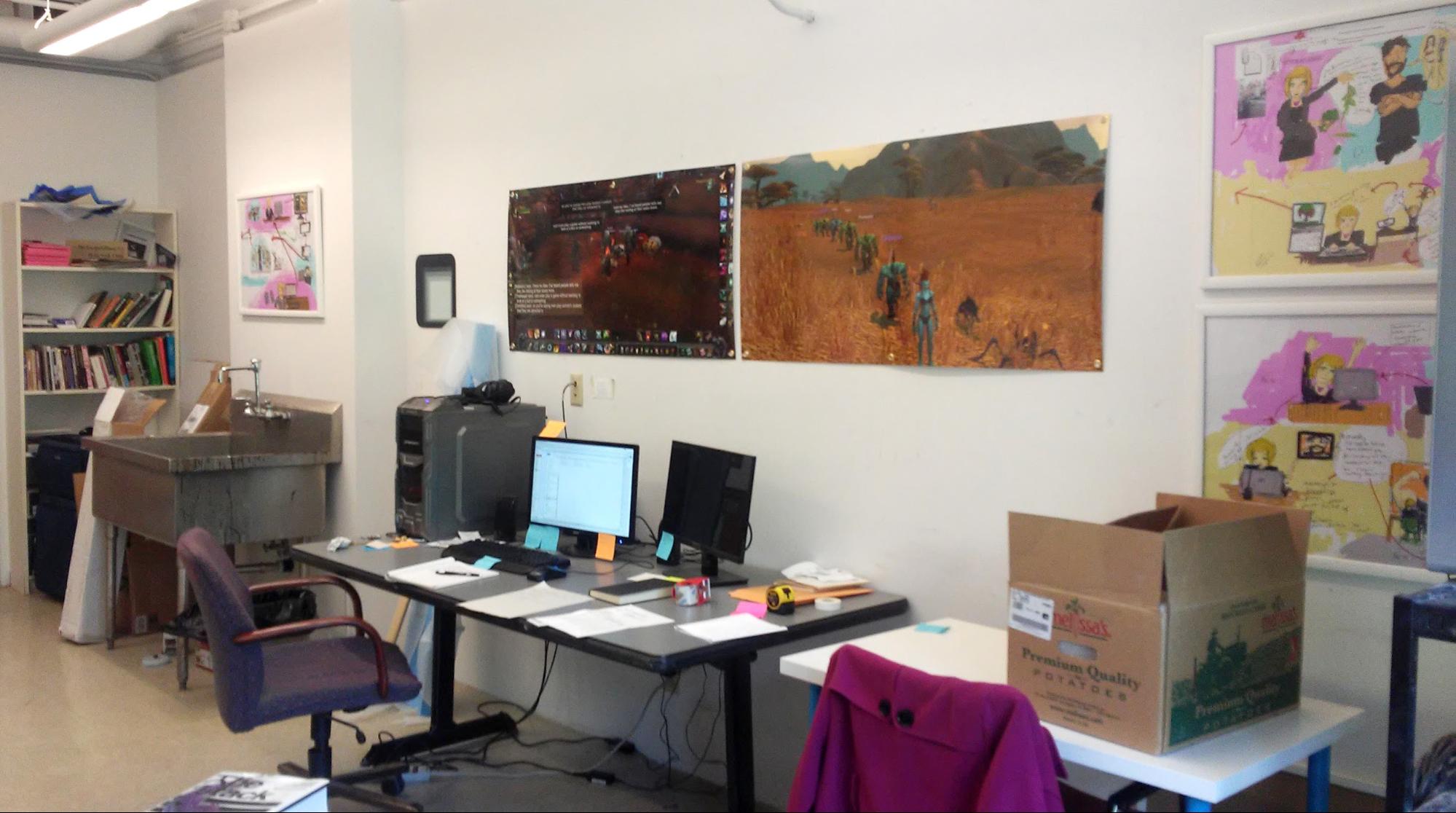
(Right side)

(Left side)
